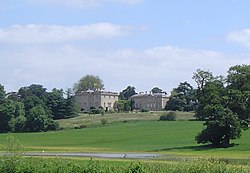Nuneham House
| Nuneham House | |
| Oxfordshire | |
|---|---|
 Nuneham House from the Thames | |
| Location | |
| Grid reference: | SU5498 |
| Location: | 51°40’41"N, 1°13’13"W |
| Village: | Nuneham Courtenay |
| History | |
| Built 1756 | |
| Country house | |
| Palladian | |
| Information | |
| Owned by: | Oxford Univresity |
Nuneham House is an eighteenth-century villa in the Palladian style, set in parkland at Nuneham Courtenay in Oxfordshire. It is currently owned by Oxford University and is used as a retreat centre by the Brahma Kumaris World Spiritual University. In September 2016 the house and a thousand acres of surrounding parkland was put up for sale for £22 million.[1]
The house was built in 1756 on the site of an earlier property and surrounding village by Stiff Leadbetter for Simon Harcourt, 1st Earl Harcourt. Interiors were designed by James Stuart and Lancelot "Capability" Brown designed the landscaped grounds. It is a Grade-II* listed building.
Lord Harcourt demolished the original village of Nuneham Courtenay in the 1760s in order to create a landscaped park around his new villa. He removed the existing village in its entirety, rebuilding it and diverting the main Oxford to London road (now the A4074).
In the 1760s Oliver Goldsmith witnessed the demolition of an ancient village and destruction of its farms to clear land to become a wealthy man's garden.[2] His poem The Deserted Village, published in 1770, expresses a fear that the destruction of villages and the conversion of land from productive agriculture to ornamental landscape gardens would ruin the peasantry.[2] He gave his Deserted Village the pseudonym "Sweet Auburn", but did not disclose the real village to which it refers. However, he did indicate it was about 50 miles from London and it is widely believed to have been Nuneham Courtenay.[2]
The house was altered by Henry Holland in 1781-2, including the heightening of the wings. In 1789 the 2nd Earl Harcourt re-erected the Carfax Conduit building in a prominent position in the park. It had had to be moved from Carfax in the centre of Oxford, where it was an obstacle to traffic.[3]
In 1904, after the death of Sir William Vernon Harcourt, Nuneham House passed to his son, Lewis Vernon Harcourt, 1st Viscount Harcourt, known by many as "Loulou". He had just married Mary Ethel Burns, a niece of American financier and banker, J. P. Morgan. The estate inherited by the young couple was in need of major renovations, which they could not afford. Morgan established a £52,000 ($260,000) line of credit at his London bank for his niece, which he told her did not need to be repaid. The Harcourts used these funds to renovate the old buildings and grounds.[4]
During World War II, Nuneham House and its surrounding parkland was requisitioned by the Ministry of Defence and became RAF Nuneham Park. It was a P.R.I.U. or photographic reconnaissance interpretation unit. Examining the photographs taken by aircraft from RAF Benson and other airfields over enemy territory were not only RAF officers but also small contingents from the Army, Royal Navy and the USAAF. Nissen huts and other, larger buildings were erected adjacent to the mansion, including a camp cinema which villagers were welcome to attend. The RAF station continued after the war in the same role until the mid-1950s, when the added buildings and roadways were demolished and the estate handed back to the Harcourt family, who sold it to Oxford University.
The Harcourt Arboretum, part of the tree and plant collection of the University of Oxford Botanic Garden, occupies part of what were the grounds of Nuneham House.
The landscaped parkland and pleasure gardens surrounding the house are listed Grade I on the Register of Historic Parks and Gardens.[5]
References
- ↑ "Oxford University hopes to sell historical estate for 22 million pounds". 23 September 2016. http://www.oxfordmail.co.uk/news/14760754.Oxford_University_hopes_to_sell_historical_1_054_acre_estate_for___22m/. Retrieved 3 October 2017.
- ↑ 2.0 2.1 2.2 Rowley, 1978, page 132
- ↑ Follies and Monuments website
- ↑ Strouse, Jean. Morgan: American Financier. Random House, 1999. pp. 384-386. ISBN 978-0-679-46275-0
- ↑ National Heritage List 1000122: Nuneham Courtney
Sources
- Rowley, Trevor (1978). Villages in the Landscape. Archaeology in the Field Series. London: J.M. Dent & Sons Ltd. ISBN 0-460-04166-5.
- English Heritage; Images of England, detailed architectural description
- Taylor, Christopher (1982) [1975]. Fields in the English Landscape. Archaeology in the Field Series. London: J.M. Dent & Sons Ltd. ISBN 0-460-02232-6.
Outside links
| ("Wikimedia Commons" has material about Nuneham House) |
- Official website - Global Retreat Centre
- Nuneham House entry from The DiCamillo Companion to British & Irish Country Houses
- "View of Nuneham Courtenay from the Thames" (1787) — painting by Joseph Mallord William Turner (1775–1851) at Tate Online
